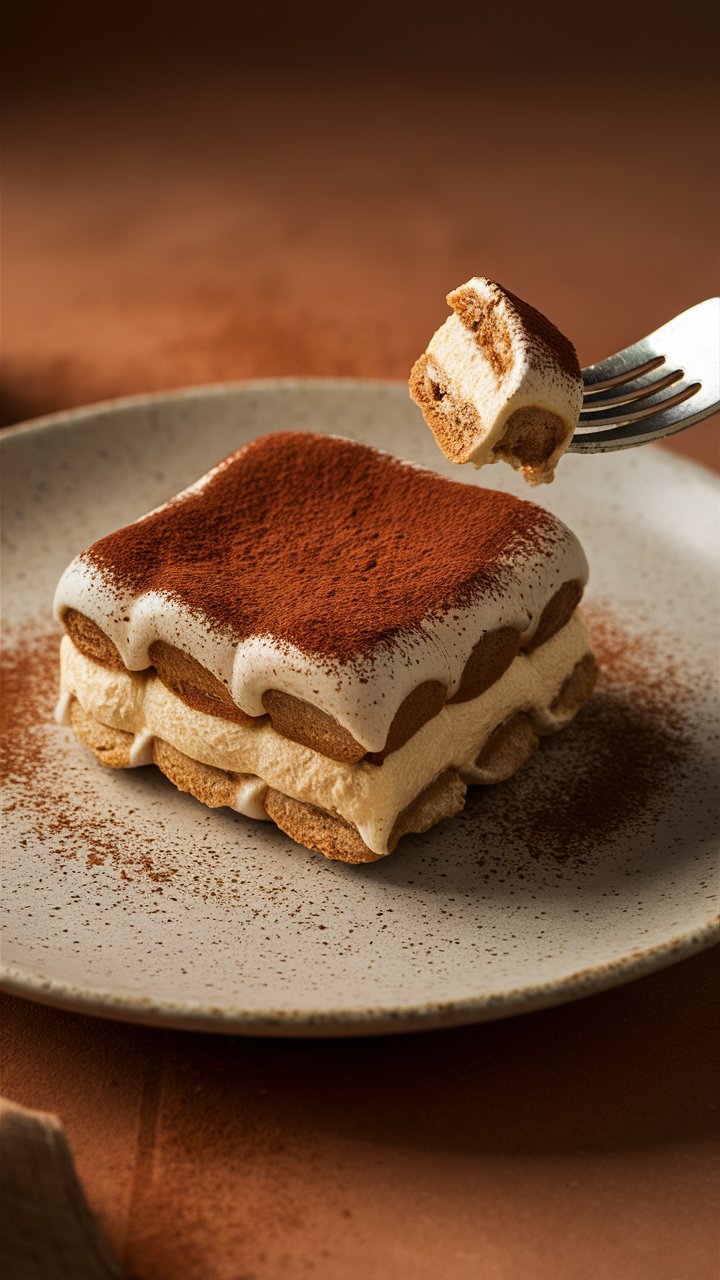The Heart of Italy in a Spoon
Few desserts in the world command as much universal love as tiramisu — that creamy, coffee-kissed Italian masterpiece whose name literally means “pick me up.” Born in the charming city of Treviso in Northern Italy, this dessert combines the richness of mascarpone cheese, the bold flavor of espresso, and the delicate texture of ladyfingers, all dusted with a whisper of cocoa.
But while countless versions exist, the original tiramisu recipe stands apart — no whipped cream, no shortcuts, and absolutely no compromise. This guide will take you beyond the surface, revealing the true Italian method, the culinary science behind each step, and the expert techniques to perfect the dessert that embodies Italian passion and simplicity.
🇮🇹 The True Origins of Tiramisu
The history of tiramisu is as rich as its flavor. The story begins in the 1960s at Le Beccherie, a family-run restaurant in Treviso, in Italy’s Veneto region. It was here that Ado Campeol, the restaurant’s owner, and Carminantonio Iannaccone, his pastry chef, created what would soon become a global icon.
The name tiramisu — “pick me up” — symbolized both the dessert’s uplifting taste and the energy boost from its espresso content. Unlike the cream-heavy versions found in many cafés today, the authentic recipe used only egg yolks, sugar, mascarpone cheese, espresso-soaked ladyfingers, and cocoa powder — nothing more, nothing less.
This minimalist perfection remains the hallmark of the original Italian tiramisu — elegant, balanced, and deeply satisfying.
🧈 Ingredients and Their Culinary Purpose
Each ingredient in tiramisu has a precise role. Using the right components, in the right proportions, is key to achieving the authentic texture and flavor Italy is famous for.
For 8 Servings:
- 6 large egg yolks — the foundation of the rich zabaglione cream.
- ¾ cup (150 g) granulated sugar — balances the bitterness of coffee and cocoa.
- 1 cup (240 g) mascarpone cheese, room temperature — the heart of the creamy filling.
- 1 ½ cups (360 ml) strong espresso, cooled — provides depth and aroma.
- 2 tbsp Marsala wine (optional) — a classic Venetian touch.
- 24–30 ladyfingers (Savoiardi biscuits) — structure and subtle sweetness.
- Unsweetened cocoa powder, for dusting.
Ingredient Science
- Mascarpone: High in fat, mascarpone creates the smooth, velvety texture essential to tiramisu. Substitutes like cream cheese alter both flavor and mouthfeel.
- Egg Yolks: Their emulsifying power binds the cream, giving it body without heaviness.
- Espresso: Provides bitterness that balances sweetness, enhancing complexity.
- Cocoa: Adds aromatic contrast and visual allure — the final touch of elegance.
👩🍳 Step-by-Step: How to Make Authentic Tiramisu
Step 1: Prepare the Zabaglione
In a heatproof bowl, whisk the egg yolks and sugar together until pale and creamy.
Place the bowl over a pot of gently simmering water (bain-marie).
Whisk continuously for 7–8 minutes until the mixture thickens into a glossy custard.
Remove from heat and let it cool slightly.
🧠 Expert Tip: Don’t rush the cooking process — slow heating prevents the eggs from scrambling and gives the cream its silky texture.
Step 2: Add the Mascarpone
Once the zabaglione has cooled to room temperature, fold in the mascarpone cheese gently until smooth and uniform. Avoid overmixing, which can cause curdling.
Step 3: Brew and Cool the Espresso
Prepare a strong espresso (or moka pot coffee). Allow it to cool completely before dipping the ladyfingers — warm coffee can make them disintegrate.
For a Venetian flair, stir in Marsala wine, though purists often prefer the coffee unaltered.
Step 4: Assemble the Layers
Quickly dip each ladyfinger into the espresso for about 1 second per side — they should absorb the coffee without becoming soggy.
Arrange a layer of soaked ladyfingers at the base of your serving dish.
Spread half of the mascarpone cream evenly over the top.
Repeat with another layer of coffee-soaked ladyfingers and finish with the remaining cream.
🧠 Pro Tip: Smooth the top using an offset spatula for a clean, elegant presentation.
Step 5: Chill to Perfection
Cover the dish with plastic wrap and refrigerate for at least 6 hours, ideally overnight.
This resting period allows the flavors to meld and the cream to set to a perfect firmness.
Step 6: Dust and Serve
Just before serving, dust generously with unsweetened cocoa powder using a fine sieve.
Serve chilled, and savor the interplay of creamy, bitter, and sweet — the hallmark of authentic tiramisu.
💡 Expert Tips for the Perfect Tiramisu
- Use fresh eggs only. They provide both safety and better structure.
- Choose real mascarpone. Avoid substitutes — mascarpone’s texture is unique.
- Chill thoroughly. Tiramisu tastes best after resting 12–24 hours.
- Avoid whipped cream. Traditional tiramisu relies on the zabaglione for creaminess, not whipped dairy.
- Dust only before serving. Cocoa can darken and lose aroma if applied too early.
🧊 Storage, Make-Ahead & Freezing Tips
- Refrigeration: Store tiramisu in an airtight container for up to 3 days. The flavor deepens over time.
- Freezing: You can freeze tiramisu (uncocoaed) for up to 3 months. Thaw overnight in the fridge before dusting with cocoa.
- Make-Ahead Tip: Prepare a day before serving for the richest, most harmonious flavor.
🌱 Variations & Modern Adaptations
While the original tiramisu recipe remains unbeatable, modern adaptations offer inclusivity for every palate:
- Alcohol-Free Tiramisu: Omit Marsala and rely solely on espresso.
- Eggless Version: Replace zabaglione with whipped mascarpone and condensed milk.
- Vegan Tiramisu: Use cashew cream, coconut milk, and vegan ladyfingers.
- Gluten-Free Tiramisu: Choose gluten-free sponge fingers for a celiac-friendly dessert.
Each variation retains the essence — layers of coffee, cream, and cocoa — but with a modern twist.
❓ Frequently Asked Questions
Why is my tiramisu watery?
Usually due to over-soaked ladyfingers or under-chilled cream. Dip biscuits quickly and chill for at least 6 hours.
Can I use cream cheese instead of mascarpone?
You can, but the flavor will be tangier and less authentic. Mascarpone offers a buttery, mild richness.
What coffee works best for tiramisu?
Strong espresso made from Arabica or a blend with Robusta gives the ideal bitterness and aroma.
Is alcohol mandatory?
No. The original recipe often didn’t include it — it’s purely optional and a matter of regional preference.
🏁 Conclusion: The Soul of Authentic Tiramisu
The original tiramisu recipe isn’t about complexity — it’s about precision, patience, and respect for tradition. From the zabaglione’s creamy depth to the espresso’s boldness, every element plays its role in creating a dessert that feels like a warm embrace from Italy itself.
So, the next time you crave something luxurious yet comforting, remember: true tiramisu is not just made, it’s composed — like a symphony of textures and flavors.





